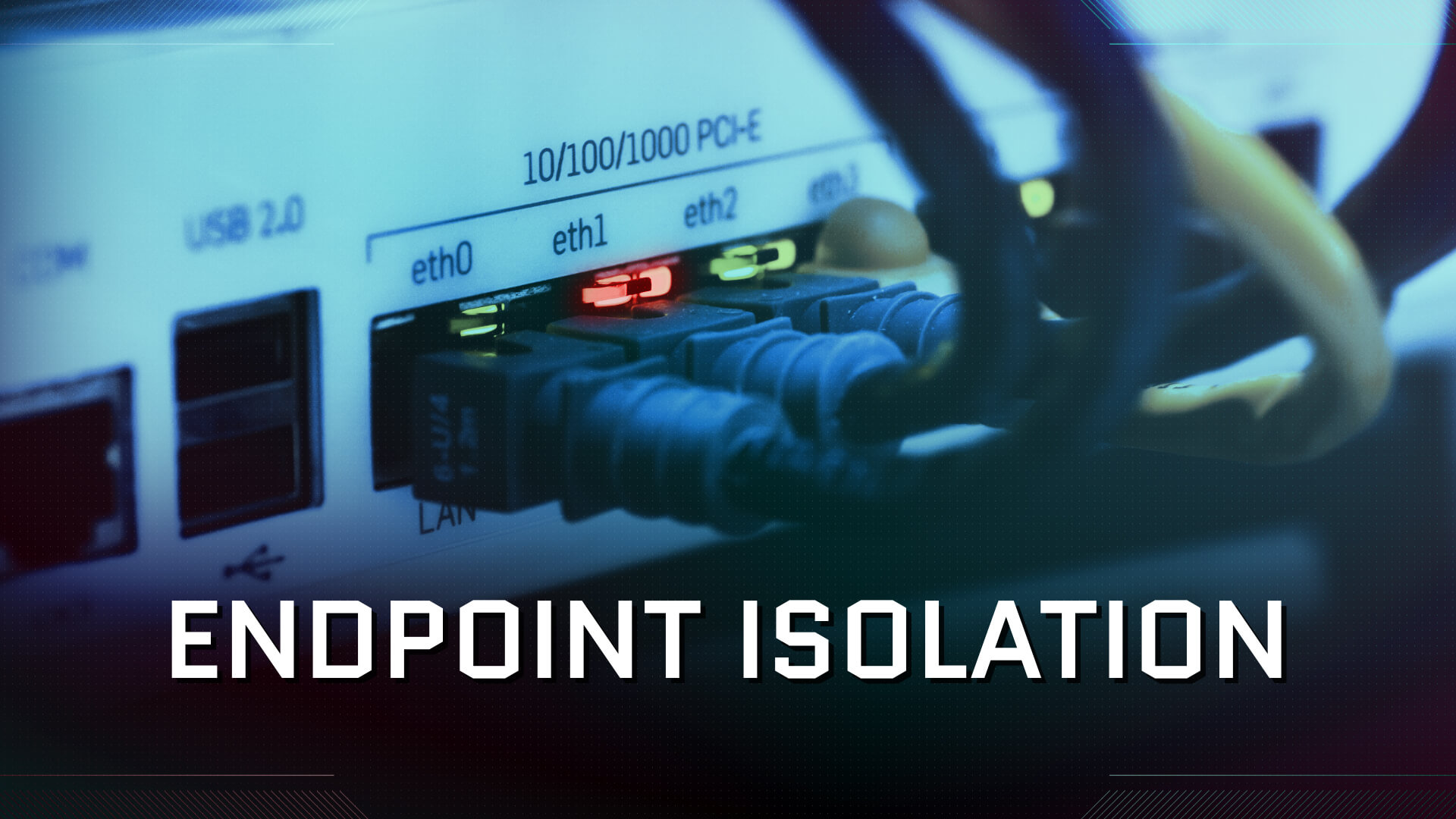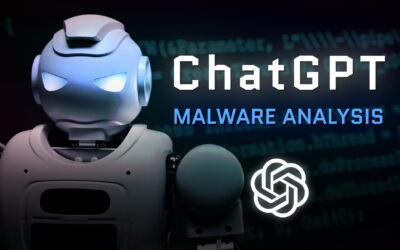ENDPOINT ISOLATION
THE ULTIMATE REMEDIATION ACTION
As a Cyber Security Analyst, one of the most critical decisions you will have to make is when to isolate an endpoint. This powerful remediation action can halt the spread of malware and prevent data exfiltration from the internal network, but it also comes with significant consequences. In this article, you will learn exactly what endpoint isolation is, when it should be used, and how to properly implement it to minimize potential adverse effects on your organization.
What is Endpoint Isolation?
Endpoint isolation is the process of preventing all incoming and outgoing network traffic on a specific endpoint. This effectively stops a malware specimen from spreading on the network, prevents it from communicating with command and control (C2) servers, and halts any attempts to exfiltrate data. However, it’s important to note that endpoint isolation does not stop a piece of malware from operating on the endpoint itself. A glaring example of this is a ransomware infection that begins to encrypt the victim. If endpoint isolation is implemented on the infected computer, the ransomware will no longer be able to spread to other computers on the network. However, it will still be able to encrypt files on the infected computer itself.
This is because endpoint isolation is capable of preventing only the flow of network traffic, but not the operations of software on the endpoint itself. This means that it is important to have other security measures in place, such as anti malware or Endpoint Detection & Response (EDR) solutions, to detect and remove malware before it can cause damage. Additionally, if a user account with access to various platforms is compromised, endpoint isolation may not be enough. The user account should be disabled, or at least the password has to be changed and any open sessions must be revoked.
In summary, endpoint isolation is a useful security measure that can help prevent the spread of malware on a network, but it is not a complete solution. It should be used in conjunction with other security measures to provide comprehensive protection against malware.
WHEN TO USE ENDPOINT ISOLATION
Endpoint isolation should be used only in emergency situations where there are strong indicators of malicious activity and immediate action is required. It’s a drastic measure that can have serious consequences on business operations, so it should only be initiated after careful consideration.
Some examples of when endpoint isolation might be used include:
• Ransomware attacks
• Attempts by threat actors to move laterally within the network
• Malware that is actively spreading and causing damage to other endpoints on the network
• Indicators of data exfiltration
• Traffic to or from known Command & Control (C2) servers
Considerations Before Isolating an Endpoint
Before isolating an endpoint, it’s crucial to understand the consequences of your actions. This includes identifying the type of endpoint, its subtype, and its function within the network. For example, isolating a mobile device or workstation will likely have less severe business disruptions than isolating a server that provides critical services. Additionally, it’s important to consider to whom the endpoint is assigned. Isolating the CEO’s workstation, for example, will have a much different impact than isolating a regular employee’s workstation.
It’s also important to consider whether there are any fallback options in place. Once an endpoint is isolated, any services or functionality that rely on it will no longer be available. This means that it is important to have contingencies in place to ensure that business operations can continue. You see, when an endpoint is isolated, the flow of network traffic flow stops completely except for the traffic between the endpoint and the EDR/MDR solution responsible for the isolation. This means that any services or functionality that rely on the endpoint will no longer be available. For instance, if a web server is isolated any website hosted on that server will no longer be accessible, or if a database server is isolated, any applications that rely on that database will no longer be able to function.
There are several fallback options that you can choose to use, such as:
• Redundancy
• Disaster recovery
• Business continuity
Redundancy means that you have multiple servers or endpoints that can take over the responsibilities of an isolated endpoint. This ensures that business operations can continue without interruption.
Disaster recovery plans are in place to quickly restore services and functionality in the event of a major incident, including those caused by nature. A disaster recovery plan may include having backups of important data and configurations, as well as procedures for quickly restoring systems.
Business continuity plans have the same goal as disaster recovery plans but the means are different. For example, having alternative methods of communication, such as a backup phone systems or email, as well as procedures for how to reassign tasks and responsibilities in the event of an incident are examples of a business continuity plan.
To give a practical example of the potential business impact of endpoint isolation, think of a retail company that has a web server that runs the e-commerce system. If this server is isolated, the e-commerce system will no longer be available to customers. This in turn means that the company will lose sales as customers are unable to make purchases through the company’s online store. To mitigate this impact, the company may have a as fallback option a backup web server that can take over the responsibilities of the primary server in case of an incident.
The Risks of Inaction
While endpoint isolation can be a powerful tool, it’s not without its risks. That’s why it’s important to weigh the potential consequences of both action and inaction. Not taking action to isolate an infected endpoint could lead to data breaches, compliance violations, and reputational damage.
As an example, if a ransomware infection is discovered on an endpoint, and the decision is made to not isolate the endpoint, the ransomware will continue to encrypt files and can potentially spread to other devices on the network. This can cause widespread data loss and can be very costly in terms of both time and money. Even if the company is able recover from this disaster, the reputational damage caused by the incident may be so great that it ultimately leads to bankruptcy.
Inaction can also lead to the compromise of sensitive information or the unauthorized access to systems. When a user account is compromised and the decision is made not to isolate the endpoint, the threat actor will continue to have access to the systems the user account has access. This can lead unauthorized access to sensitive information, exfiltration of the sensitive data, and even potentially to lateral movement within the network.
The third risk of inaction is that it can lead to non-compliance with regulatory requirements. Many industries are subject to strict regulations with regard to data protection and must take necessary steps to safeguard sensitive information appropriately. Inaction with regard to endpoint isolation can lead to non-compliance with these regulations and can result in significant fines and penalties. A prime example of this is the EU GDPR data protection regulation.
Understanding the Consequences
As a cyber security operations expert, it’s essential to weigh the potential consequences of endpoint isolation before implementing it. The decision to isolate an endpoint should not be made lightly, as it can have a significant impact on the business operations and the productivity of the endpoint’s users.
For example, if an endpoint is used for business-critical operations, such as a server that manages financial transactions or a workstation that controls a manufacturing process, isolating that endpoint can cause a significant disruption to the business. In these cases, it may be necessary to consider alternative remediation actions, such as deploying a malware removal tool or performing a forensic analysis, rather than immediately resorting to isolation.
On the other hand, if the endpoint is a personal workstation or mobile device that is not used for critical business operations, the impact of isolation may be less severe. However, even in these cases, it is essential to consider the user’s role within the organization and the potential impact on their productivity.
Implementing Endpoint Isolation
When the decision is made to isolate an endpoint, it’s essential to have a plan in place to minimize the impact on the business and the users. This may include identifying and communicating the potential impact of isolation to key stakeholders, implementing a fallback plan to restore network access if necessary, and monitoring the endpoint to ensure that the isolation is effective.
One of the best ways to implement endpoint isolation is to use a Managed Detection and Response (MDR) solution. An MDR solution can provide the necessary visibility and control to isolate an endpoint quickly and effectively, while also providing the ability to perform additional remediation actions.
Final Thoughts
Endpoint isolation is a powerful remediation action that can be used to stop the spread of malware and prevent lateral movement within the corporate network. However, it’s important to understand the potential consequences and have a plan in place to minimize its impact on the business and users. By understanding the risks and having the right tools in place, Cyber Security Analysts can make well-informed decisions and effectively implement this remediation action when it truly is necessary.
HUNGRY FOR MORE?
Cyber Security Misconceptions
Do you lack the educational background and coding skills required to land a job in the cyber security industry? Several misconceptions exist regarding what it takes to break in! Find out more why you could and should pursue a career in cyber security.
Malware Analysis with ChatGPT
CHATGPT POWERED MALWARE ANALYSISDuring late 2022 and early 2023, ChatGPT made headlines in the tech industry and everyone caught scent of the excitement! ChatGPT is a truly intriguing example of the capabilities of Artificial Intelligence, and how it can be used in...
Triage
What is Triage in the context of Cyber Security, and why is it a crucial step in Security Operations and Incident Response? Find out more!
Is coding required for Cyber Security?
Are you aspiring to work in the Cyber Security industry but lack coding skills? Is it really a must-have skill to possess in order to succeed? Find out the answer!
Do I need a college degree for Cyber Security?
Have you ever been told that you cannot get into the cyber security field without a college or university degree? If you have, you are not alone! Self-learning is a perfectly viable alternative!
IACIS Windows Forensic Examiner review
The International Association of Computer Investigative Specialists (IACIS) offers an affordable and comprehensive training solution to address the need for training in Windows Forensics.
Unable to Boot into Linux? Try this!
You have just installed a Linux distribution on your computer and now your system refuses to boot. The option you may have overlooked is Trusted Execution Technology.
How many times was a USB storage device connected to a computer?
To find the number of times a specific USB storage device was connected to a suspect computer, review the information available in Microsoft-Windows-Storsvc%4Diagnostic.evtx.
What does a Cyber Security Analyst do?
The role of a Cyber Security Analyst is one of great importance and responsibility. While the work can be highly rewarding, it also requires great deal of patience.
SANS SEC504 / GCIH – Best foundational cyber security certification!
SANS SEC504 is a six-day course that lays a solid foundation of the core principles of cyber security upon which you can build your cyber security career.












